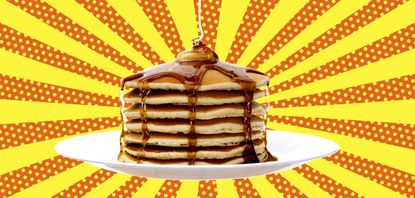It's maple syrup season, baby
Move over pumpkin spice


The best thing about fall is not knit sweaters, decorative gourds, the relief from August's blazing heat, or photos of cats in scarves. It is that, for a brief three-month period, it becomes socially acceptable to douse everything you eat in a thick, slimy layer of maple syrup.
Autumn is a season known for having the best months and the best drinks — the king among them, of course, being the pumpkin spice latte. As you travel down the autumnal drink hierarchy from there, you bounce past apple cider (hot and cold), cocoa, the lowly pumpkin beer (why), and, if you are one of those monsters who puts up a Christmas tree before Thanksgiving, probably peppermint mochas as well. No respect is given to a slow-motion shot of maple syrup — a treat as decadent as eggnog — or a simple black coffee sweetened with a swirl of Vermont's finest.
Pumpkin spice and apple cider are flavors so ubiquitous during fall that they now come in the form of festive air fresheners, breakfast cereals, and seasonal Oreos. Both pumpkin spice and apple cider, however, are just vehicles for delivering a combination of cinnamon, nutmeg, cloves, and allspice into your mouth. Maple syrup is a different beast; it needs no spices to achieve its rich, honeyed, carameled, molasses-y taste, with some varieties of the sticky liquid even channeling notes of just-barely-burned sugar.
Subscribe to The Week
Escape your echo chamber. Get the facts behind the news, plus analysis from multiple perspectives.

Sign up for The Week's Free Newsletters
From our morning news briefing to a weekly Good News Newsletter, get the best of The Week delivered directly to your inbox.
From our morning news briefing to a weekly Good News Newsletter, get the best of The Week delivered directly to your inbox.
Due to its versatility, maple syrup is unclassifiable: What is it, a food? A condiment? A drink? If sampled in spoonfuls by itself, one might even be able to discern the unique taste of the individual farm; syrup is as finicky and varied as wine, its flavor changing by the season and region where it was tapped. The arboreal ambrosia, coaxed from tree trunks every spring by the noble farmers of Canada, Vermont, and New York (and, appallingly, Massachusetts), starts as a clear golden color at the beginning of sugaring season in the spring, darkening into a rich candied reddish-brown as the days warm. Every flavor in the resulting auburn rainbow is delectable, so complex that it takes a connoisseur to describe the precise notes, of orange peel, perhaps, or vanilla.
With a former Vermonter's bias toward the state's family-owned farms, Sugarbrush is one of my favorites, making an amber that is light and versatile enough for everyday use and can be ordered by the gallon in the classic opaque plastic jug. Likewise, Vermont's Sugar Shack offers a "dark robust" syrup (formerly known as "grade B"), which has a bolder, molasses-like flavor that can overwhelm pancakes but is perfect for baking or spooning on its own. On the other hand, a light and delicate syrup, like Michigan's Harwood Gold, adds just the right amount of sugar to coffee, but lacks oomph as a topping.
Understandably, many people have not yet experienced these abundant wonders, due simply to the fact that maple syrup is limited in our cultural conscious to a condiment for flat breakfast foods like pancakes, waffles, and French toast. This should be blamed on the limits of imagination: Maple syrup is the perfect upgrade for otherwise boring foods. Break out the M.S. as dressing on your salad. Glaze some carrots. Mix with butter. Slather on a ham. Top a bowl of ice cream. Stir in an old fashioned as a compliment to whiskey, the other best food. Go wild.
That is not, however, to dismiss the mighty pancake, syrup's most loyal friend. Just be sure to dump a golden sea of syrup on your plate before consuming your flapjacks the way they deserve. Beware, though, of corn syrup substitutes like Aunt Jemima or Mrs. Butterworth's — although The Washington Post discovered that 70 percent of Americans prefer those knock-offs, which tend to be less expensive than the liquid gold that comes out of the northeast.
Sign up for Today's Best Articles in your inbox
A free daily email with the biggest news stories of the day – and the best features from TheWeek.com
Canadians, at least, know how to pay homage. Our neighbor to the north put a symbol of maple syrup right on its flag. It even has a "strategic maple syrup reserve" out of precautionary economic necessity. In the Great Canadian Maple Syrup Heist of 2012, some $30 million worth of the slow-moving liquid was stolen — the highest-value heist ever to take place in Canada.
Still, there are detractors. "It's just sugar," complain naysayers and, by deduction, the worst people on Earth. But maple syrup has at least 24 different antioxidants, writes a website called Healthline, which also calls it "slightly 'less bad' than sugar" (boom). There is also an alternative healthy concoction called "maple water," which boasts that "only a tree could manufacture water this pure and this hydrating." I admit to being dubious, because why dilute a good thing, but it is apparently an option when you're in need of a quick fix.
Really, we are living in an era when it seems no one can doubt maple's glacial march toward eventually dominating the fall season. Starbucks at last introduced a maple pecan latte last year, ruffling the feathers of Big Pumpkin. Sap-flavored nonalcoholic beverages were up almost 85 percent between 2016 and 2017, according to industry analyst Technomic. Face it: This is maple's world now, baby. You're just living in it.
I am only the messenger, though, a mere town crier reminding you that with the advent of fall comes renewed permission to eat as much maple syrup as you can before it stops being acceptable sometime around Dec. 21, when we all agree to switch over to eating pies. I don't know everything there is to know about maple syrup. But I can ask you this: If your kitchen counters don't squelch with sticky syrup residue, are you even really living?
Jeva Lange was the executive editor at TheWeek.com. She formerly served as The Week's deputy editor and culture critic. She is also a contributor to Screen Slate, and her writing has appeared in The New York Daily News, The Awl, Vice, and Gothamist, among other publications. Jeva lives in New York City. Follow her on Twitter.
-
 'The disconnect between actual health care and the insurance model is widening'
'The disconnect between actual health care and the insurance model is widening'Instant Opinion Opinion, comment and editorials of the day
By Anya Jaremko-Greenwold, The Week US Published
-
 Cautious optimism surrounds plans for the world's first nuclear fusion power plant
Cautious optimism surrounds plans for the world's first nuclear fusion power plantTalking Point Some in the industry feel that the plant will face many challenges
By Justin Klawans, The Week US Published
-
 Explore new worlds this winter at these 6 enlightening museum exhibitions
Explore new worlds this winter at these 6 enlightening museum exhibitionsThe Week Recommends Discover the estrados of Spain and the connection between art and chess in various African countries
By Catherine Garcia, The Week US Published